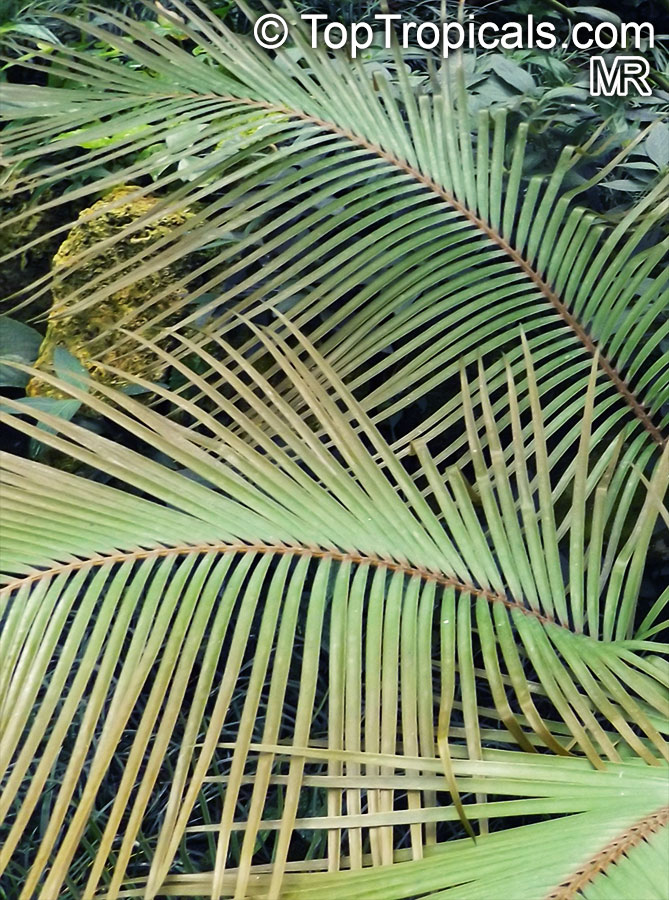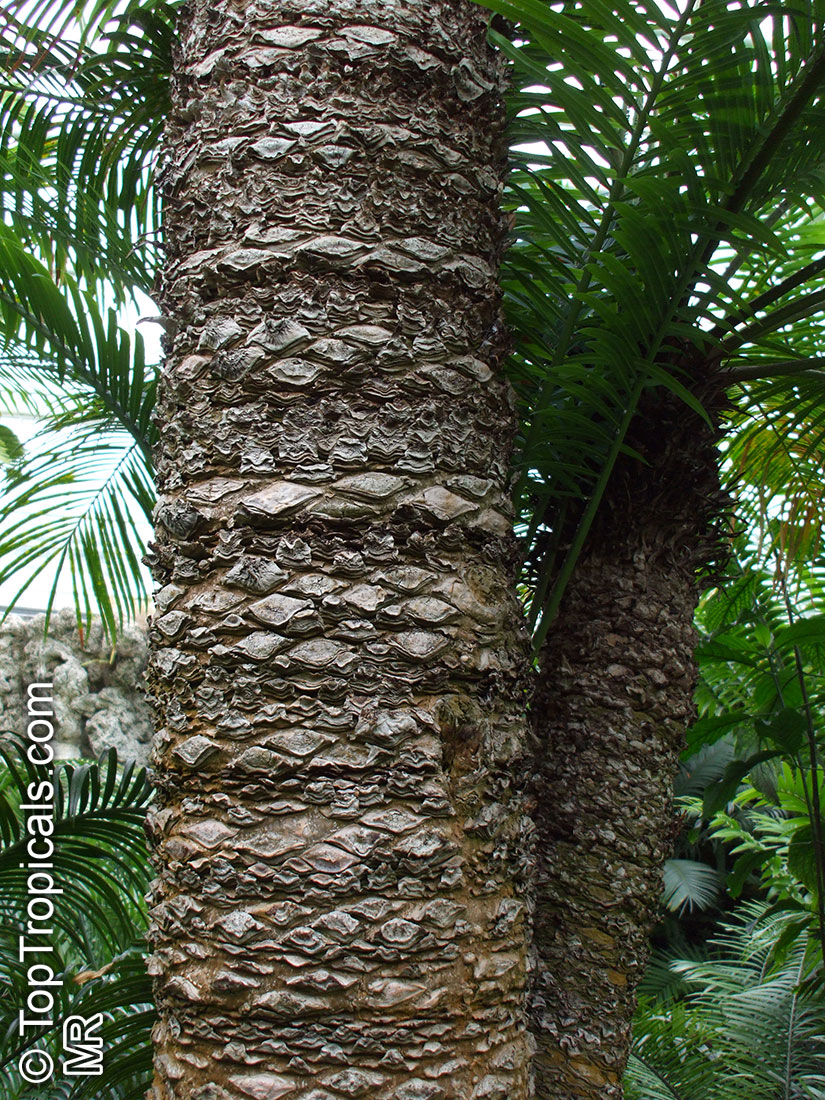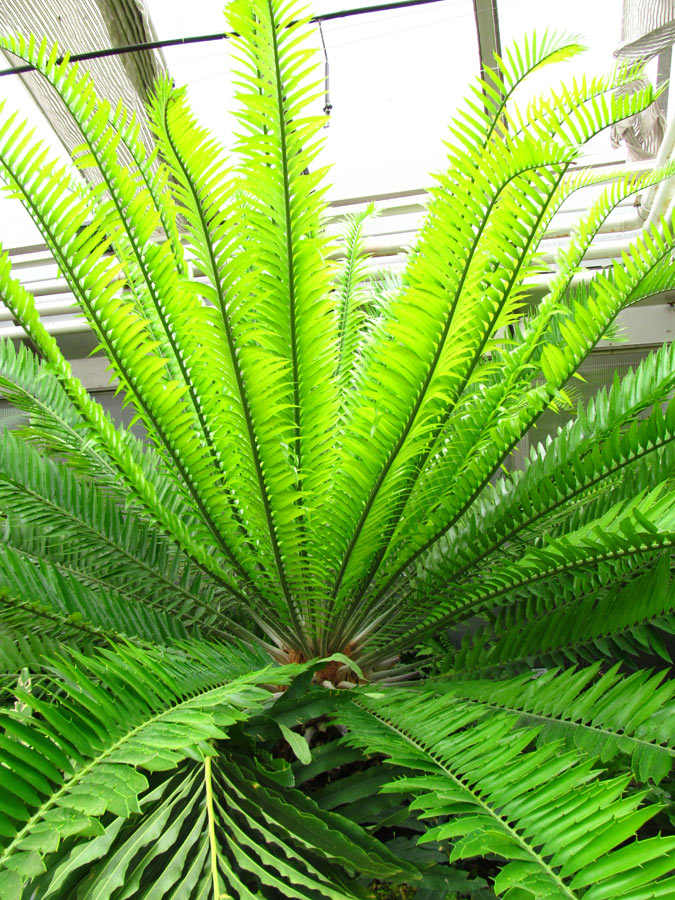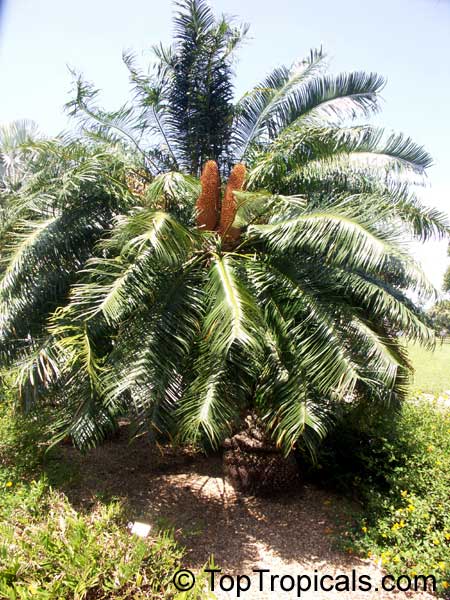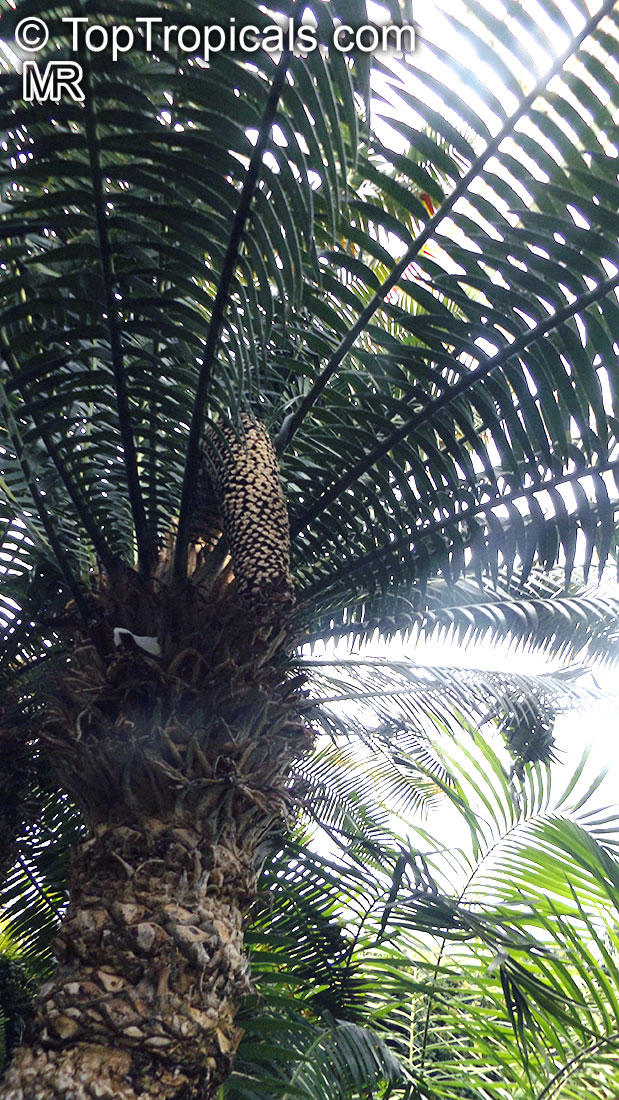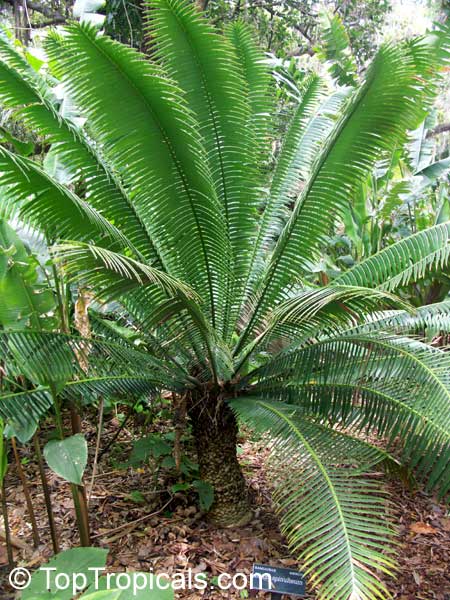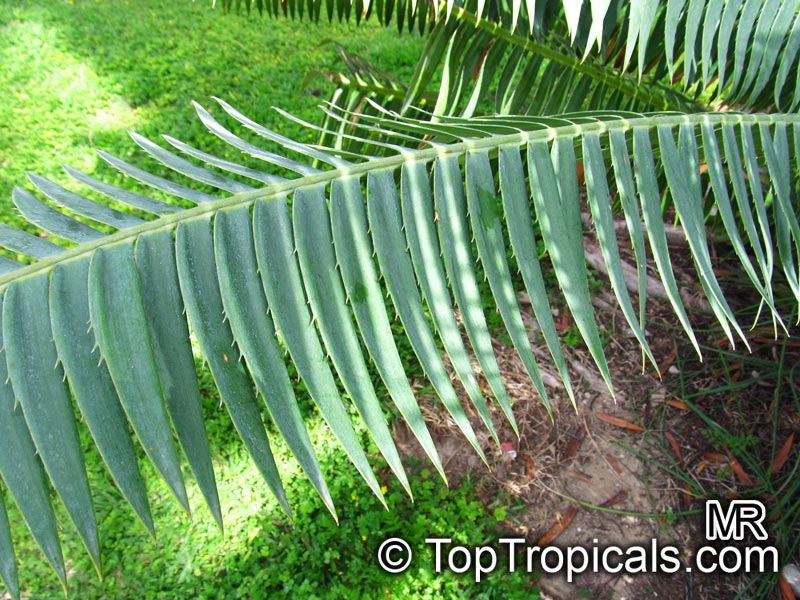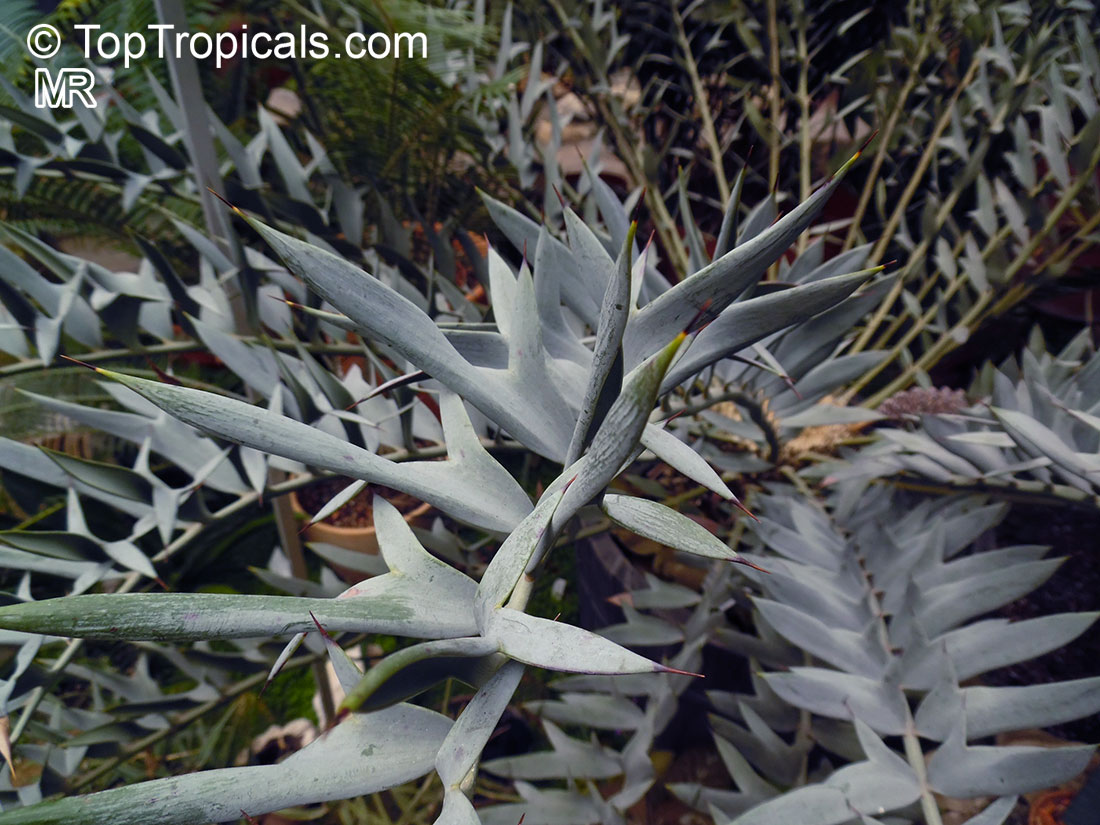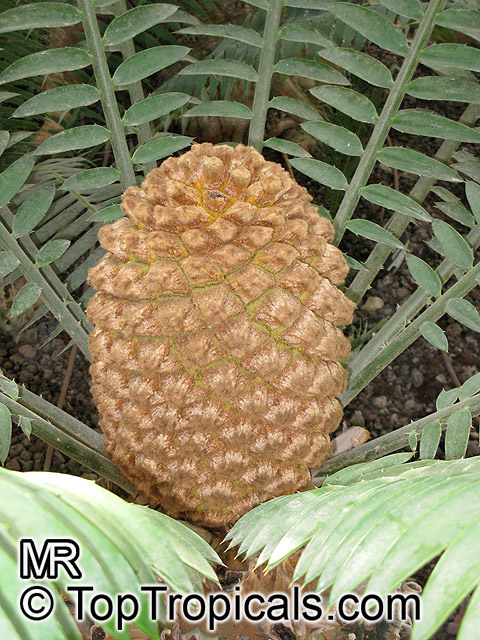Zamiaceae - Botanical Family
Top Tropicals Plant Encyclopedia
| Number of plants found: 17 | Next | 
|
Go to page: | 1 | 2 |
Botanical name: Ceratozamia mexicana
Common names: Palmilla, Forest Pineapple
Family: Zamiaceae
Origin: Mexico, Guatemala







Ceratozamia mexicana is an impressive large cycad native to Mexico and Guatemala, growing to between 5-10 ft tall. It has ornamental foliage, with dark green smooth leaves and is covered in thorns and spines providing a dense texture. In its natural habitat, the trunk can grow to up to 2m in length and a diameter of 30cm and will spread away from its base.
This species is well suited to tropical and warm subtropical regions and can be grown anywhere within the USDA Zone 9-11. The Ceratozamia mexicana will thrive in full sun and in areas of semi-shade. When grown in full sun, special care should be taken to protect this plant from long periods of excessive heat. Ideal environments will be those with morning sun or filtered light.
The Ceratozamia mexicana requires regular watering and moderate amounts of fertilizer. To maintain its health and vigor, it is best to mulch around the plant, keeping the soil moist and helping to keep weeds at bay. In cold regions it can be grown in a container, allowing gardeners to over winter them indoors if temperatures drop to below 40F.
Despite its need for greater care in cold conditions, the Ceratozamia is a beautiful and rewarding plant and with the correct conditions and care can prove to be an impressive addition to any garden.
Botanical name: Ceratozamia sp.
Common name: Ceratozamia
Family: Zamiaceae
Origin: Central America, Mexico





The plants are dioecious, with a globose or cylindrical stem, rarely dichotomously branched, that may be underground or emergent. The leaves are pinnately compound, straight, and spirally arranged. Leaf bases are usually deciduous but sometimes persistent. The petioles and rachis often have spines, though there may be very few to none. Leaflets are simple, entire, and articulate at the base, with parallel side veins and no distinct central vein.
Botanical name: Dioon sp.
Common name: Virgin Palm
Family: Zamiaceae
Origin: Mexico







Dioon mejiae is a popular cycad, suited to subtropical and temperate regions. With its ability to adapt to a variety of climates and conditions, it is widely grown and admired in gardens around the world. It is best suited to full sun and well-draining soils, and benefits from regular watering during summer. It also has great tolerance for light to moderate frosts.
Dioon mejiae is known for its small, palm-like shrub form and attractive, ornamental foliage. It has a natural range from Mexico, with its ability to withstand salt spray allowing it to become an ideal choice for coastal gardens in USDA Zones 9-11. For cold regions, it may be grown in a pot, but special care must be taken to ensure it is situated in sandy, well-draining soil, placed in a sheltered location, and watered and fertilized regularly.
When planting Solanum torvum, it is recommended to incorporate compost or other organic material into the soil. To ensure optimal growth, its roots must be kept moist but not overly wet, and its fronds should be pruned regularly to shape and encourage healthy new growth, as well as to remove any dead or damaged parts of the plant. With its abundance of rich colors and sweet aromas, this species is a beautiful sight to behold and can bring a magical effect to any garden with proper care.
Botanical name: Dioon spinulosum
Common names: Giant Dioon, Gum Palm
Family: Zamiaceae
Origin: Mexico






In full sun, Giant Dioon (Dioon spinulosum) grows into a large plant up to 20 ft tall, while in semi-shade the plants form a nice small shrubs up to 10 ft tall. The trunk of this tree is interesting, being upright and covered with small spines. In the right conditions, it can be a real show stopper.
Giant Dioon needs moderate water, but can tolerate short dry spells as they are adapted to live in semi-arid environments. While it's native to Mexico, it can grow well in other parts of the world with a mild climate. In warmer regions it will be able to tolerate temperatures in the 30s F for a short time.
For those who have cold winters, you can still enjoy a Giant Dioon by planting it in a large pot and placing it in a sheltered area, such as a south-facing wall. In colder climates, use a good-quality compost to create an insulated environment for the plant. Fertilize regularly with a balanced fertilizer and keep an eye out for any signs of fungal diseases or pests. Make sure the soil doesn't become too wet in winter as it can be hard to dry out and the roots can rot.
With the right care and plenty of sun, your Giant Dioon will be a great addition to your garden, adding structure and a unique look.
Botanical name: Encephalartos ferox
Common name: Tongaland Cycad
Family: Zamiaceae
Origin: South Africa






Encephalartos ferox is a small shrub that originates from South Africa. It typically grows to a height of between 2-5 ft and is well known for its attractive dark green foliage. But that's not all - it also has spectacular orange-red to scarlet cones, adding an extra dramatic element.
This plant prefers full sun and regular water. It is able to tolerate moderate water, but should not be exposed to waterlogged soils. Be aware when handling this plant - it can be quite thorny or spiny and should be handled with care.
In terms of cold hardiness, the mature plants can tolerate temperatures of at least 30 degrees Fahrenheit during short periods. It is suitable to be grown in USDA zones 8-11. If you are looking to grow this plant in a pot in cold regions, you will need a large container to provide protection against the cold weather and to ensure that soils do not get waterlogged. For protection against frost, cover the container with a thick blanket. Avoid over-watering the plants as this can cause root rot, and ensure to water it moderately and deeply. Pruning may be necessary to contain its size and shape, as needed.
Botanical name: Encephalartos gratus
Common names: Malawi Cycad, Mulanje Cycad
Family: Zamiaceae
Origin: East Africa





Botanical name: Encephalartos hildebrandtii
Common names: East African Sago Palm, Mombasa Cycad
Family: Zamiaceae
Origin: East Africa






Encephalartos hildebrandtii is a spectacular, evergreen, arborescent cycad. Its trunk grows to 30 cm in diameter, and it can grow over time to 6 m tall. Each stem is topped with a crown of long, stiff fronds up to 3 metres long, with slightly keeled leaflets having more than 3 teeth on their edges, and a 2-3 spines forming "trident" tips. New leaves emerge a very attractive orange to olive green, hardening off to a glossy dark green.
Botanical name: Encephalartos horridus
Common name: Eastern Cape Blue Cycad
Family: Zamiaceae
Origin: South Africa





This is a very hardy, adaptable, relatively slow-growing cycad and suited to temperate and subtropical regions. This is one of the famous "blue" Encephalartos.
Botanical name: Encephalartos lehmannii
Common name: Karoo Cycad
Family: Zamiaceae
Origin: South Africa






It's habitat is semi-arid sandstone slopes of Easter Cape Province, South Africa. Very hot and dry in summer, cold and wet in winter, with frosts being common. Lehmanii grows as a clumping, medium sized plant to about 2 m. This is one of the famous "blue" Encephalartos, and said to be the easiest to grow. It requires full sun, and extremely well drained soil. Frost tolerant -5C.
Wild populations of Encephalartos lehmannii are threatened by habitat destruction and collection of plants for horticultural and medicinal uses.
Botanical name: Encephalartos natalensis
Common names: Natal Cycad, Natal Giant Cycad
Family: Zamiaceae
Origin: South Africa







Encephalartos natalensis is relatively quick-growing palm-like cycad with an erect stem.
Leaflets are wide, deep, dark green and only have a spine or two at the tip. Some forms almost spineless.
| Next |  |
Use link to repeat this search:
https://toptropicals.com/cgi-bin/garden_catalog/cat.cgi?search_op=and&keyword_op=and&language=e&family=Zamiaceae&number=10
&no_change_lang=1&user=tt&sale=1&first=0












